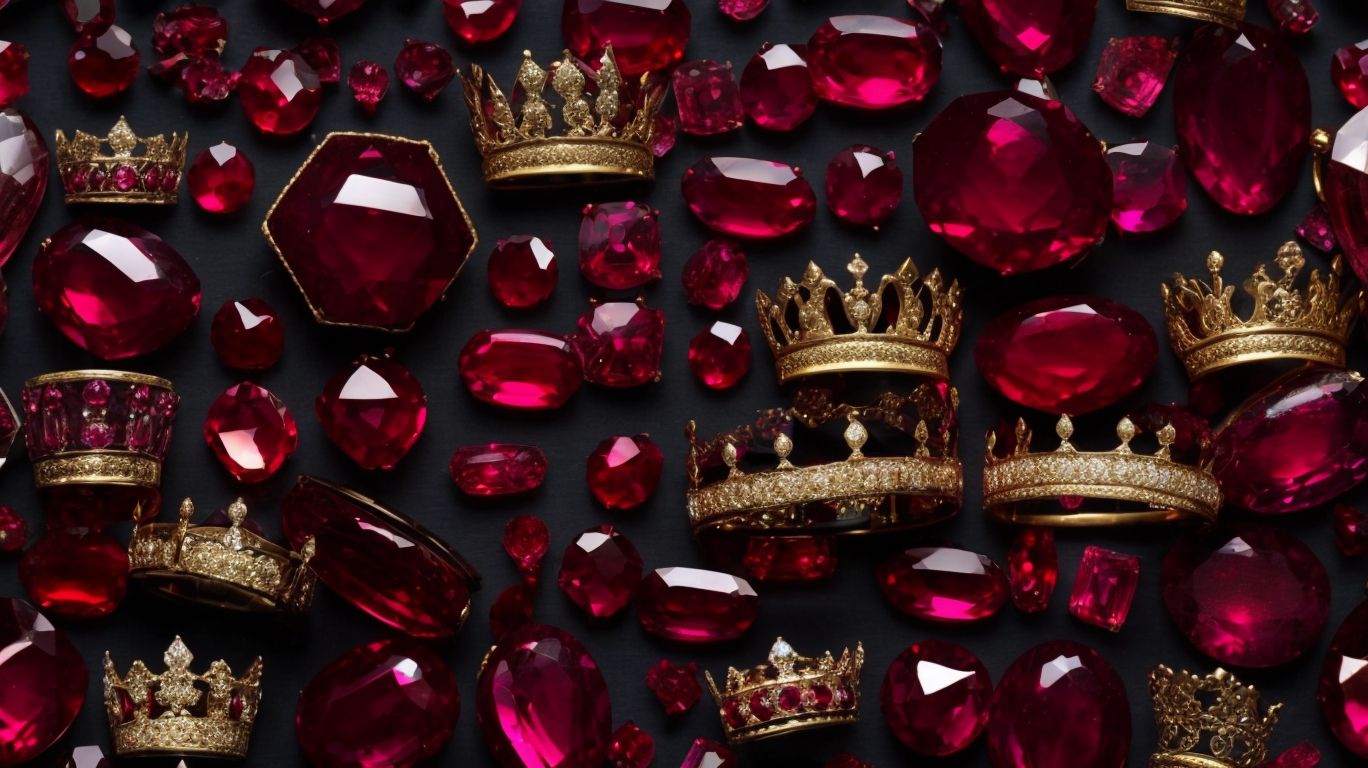
Rubies and Royalty: How the ‘King of Gems’ Shaped History
Rubies have long been known as the “King of Gems” due to their striking color and rarity, making them highly valuable in the world of jewelry.
But what sets a high-quality ruby apart from the rest? How have these precious stones played a role in the history of royalty throughout various cultures and kingdoms?
This article explores the fascinating influence of rubies on art, fashion, and modern society, from famous royals who have owned rubies to the symbolism they hold in different societies.
Join us as we delve into the world of rubies and discover how these gems continue to shape history and the world of royalty.
What Makes Rubies So Valuable?
Rubies are one of the most valuable gemstones in the world, prized for their exquisite beauty, historical significance, and deep cultural symbolism.
Their high value is influenced by various factors, including their rarity, which makes them highly sought after by gem collectors and connoisseurs. The intense red color of rubies, known as ‘pigeon blood red,’ adds to their allure and distinguishes them from other gemstones. Throughout history, rubies have been associated with power and wealth, with notable figures such as kings and emperors adorning themselves with these precious gems. This historical significance has elevated rubies to the status of the ‘King of Gems,’ symbolizing passion, protection, and prosperity across different cultures.
What Are the Characteristics of a High-Quality Ruby?
High-quality rubies exhibit exceptional attributes such as vivid color saturation, clarity, and precise craftsmanship that enhance their value and significance.
These top-grade rubies typically display a rich red hue with secondary tones such as pink or purple, which make them highly coveted in the market. The clarity of a premium ruby is crucial, as it ensures that the gemstone is free from visible inclusions that can affect its overall appeal. Expertly cut rubies not only maximize their brilliance but also bring out the inherent fire and sparkle that distinguish them from other gemstones. The carat weight of a ruby contributes to its rarity and value, with larger stones being particularly prized by collectors and connoisseurs.
The History of Rubies in Royalty
The history of rubies in royalty is rich and storied, with monarchs and rulers throughout history adorning themselves with these royal gems as symbols of power and prestige.
Rubies have long been revered for their deep red hues, believed to symbolize vitality, passion, and courage. From ancient civilizations to modern-day monarchies, rubies have held a special place in the world of royal jewels. These precious gemstones have been prominently featured in crown jewels, tiaras, and other regal ornaments, serving as focal points of majesty and opulence.
Notable historical figures like Queen Victoria of England and Catherine the Great of Russia were known for their fondness for rubies, incorporating them into their royal collections with grandeur and flair.
What Cultures and Kingdoms Have a History with Rubies?
Various cultures and kingdoms have a rich history with rubies, with gem trade routes spanning regions and industries that highlight the gem’s widespread association with royalty and power.
Throughout history, rubies have held a coveted place in the adornment of monarchs and nobility, symbolizing wealth, protection, and passion. In ancient times, these precious stones were exchanged along the Silk Road, linking the kingdoms of the East and West. Rubies were not only valued for their beauty but also believed to possess mystical powers, offering strength and vitality to those who wore them. This deep-rooted connection between rubies and royalty cemented their place in the annals of gemstone history.
How Did Rubies Become Associated with Royalty?
Rubies became closely associated with royalty due to their symbolic significance, believed to bestow power, protection, and prosperity upon those who possessed these precious stones.
Throughout history, rubies have been revered for their deep red hues, with cultures around the world attributing mystical powers to these gemstones.
In ancient times, it was thought that rubies could offer protection from harm and grant the wearer success in battle. In various myths and legends, rubies were often linked to themes of love, passion, and courage, making them highly sought after by rulers and leaders seeking to enhance their authority.
The allure of rubies in royal circles also extended to religious contexts, where they were seen as a symbol of divine favor and strength.
What Famous Royals Have Owned Rubies?
Numerous famous royals throughout history have owned exquisite rubies, with these royal gems often featuring prominently in crown jewels, private collections, and regal attire.
The allure of rubies to royalty goes beyond just their stunning beauty; they are seen as symbols of power, passion, and prosperity. For instance, Queen Elizabeth II of England is known to have a penchant for rubies, with some of the most notable pieces in the British Crown Jewels, like the Burmese Ruby Tiara, containing these fiery gemstones. Similarly, the Mughal emperors of India had a deep appreciation for rubies, using them to adorn their crowns and ceremonial robes, symbolizing their royal status and authority.
The Symbolism and Meaning of Rubies
Rubies hold deep symbolism and meaning across various cultures, representing themes of love, passion, vitality, and protection in the collective consciousness of humanity.
These vibrant gemstones have long been associated with matters of the heart, believed to amplify feelings of love, desire, and commitment. In many societies, rubies are seen as stones of courage and strength, inspiring individuals to pursue their dreams with determination and resilience. The deep red hue of rubies is often linked to life force energy, fostering vitality and inner strength. Many traditions view rubies as powerful talismans, offering protection against negative energies and bringing good fortune to those who wear them.
What Do Rubies Represent in Different Cultures?
In various cultures, rubies represent diverse symbols and beliefs, embodying themes of prosperity, vitality, and divine protection that have endured through generations.
These vibrant gemstones have long been revered for their deep red hue, often associated with passion, energy, and good fortune. In some societies, rubies are believed to bring courage and strength to the wearer, serving as a talisman against negative energies.
The significance of rubies extends beyond material wealth to encompass emotional and spiritual well-being, with some traditions viewing these precious stones as conduits of love and loyalty. The cultural heritage surrounding rubies is rich and multifaceted, weaving intricate stories of power, resilience, and the human connection to the earth’s natural treasures.
How Do Rubies Tie into the Concept of Royalty?
Rubies are intricately tied to the concept of royalty, symbolizing luxury, power, and divine favor, making them a natural choice for adorning the regal attire of monarchs and noble figures.
The rich, deep red hue of rubies has long been associated with strength, passion, and courage, qualities that mirror the characteristics expected of rulers and leaders. Throughout history, monarchs and aristocrats have adorned themselves with these precious gemstones not only for their beauty but also for the symbolism they carry.
Rubies have the ability to command attention and respect, elevating the wearer’s status and projecting an image of authority and prosperity. Their allure extends beyond mere decoration, shaping the perception of power and wealth in society for centuries.
The Influence of Rubies on Art and Fashion
Rubies have left a lasting imprint on art and fashion, inspiring masterpieces of jewelry design and influencing trends that celebrate the allure of these precious gems.
Throughout history, rubies have been featured in iconic pieces of jewelry, gracing crowns, necklaces, and rings worn by royalty and celebrities. The craftsmanship involved in creating ruby-adorned masterpieces is truly remarkable, with skilled artisans meticulously setting these vibrant gems to showcase their rich red hues.
From ancient civilizations to modern runway shows, rubies continue to captivate designers and fashion enthusiasts alike, symbolizing passion, love, and prosperity. Their timeless beauty and cultural significance have solidified their place as a coveted gemstone in the world of art and fashion.
How Have Rubies Been Featured in Art Throughout History?
Rubies have been prominently featured in art throughout history, showcasing their cultural influence, exquisite beauty, and the skilled craftsmanship required to highlight their allure.
These mesmerizing gemstones have captured the fascination of artists across diverse cultures and epochs, inspiring magnificent creations that stand as testaments to the enduring appeal of rubies.
From the vibrant red hue symbolizing passion and vitality to the association with wealth and power, rubies have held a revered place in artistic expression.
In paintings, artists such as Van Eyck and Botticelli incorporated rubies into their works to symbolize love and desire. Sculptors like Cellini skillfully integrated rubies into intricate designs, adding a touch of opulence and sophistication to their masterpieces.
What Are Some Famous Pieces of Jewelry Featuring Rubies?
Famous pieces of jewelry featuring rubies have graced the collections of royalty, with these exquisite gems symbolizing luxury, power, and a timeless allure in the gemstone market.
Renowned for their vibrant red hue and captivating sparkle, rubies have been a favorite choice for crafting iconic jewelry pieces. One notable example is the Burmese Ruby Tiara worn by Queen Elizabeth II, a stunning display of rubies set in intricate gold and diamond settings.
The craftsmanship behind such regal pieces often involves skilled artisans meticulously selecting and setting the rubies to enhance their natural beauty and create a striking visual impact. These rare gemstones are not only prized for their beauty but also carry a rich history and symbolism that adds to their allure in the luxury market.
How Have Rubies Inspired Fashion Trends?
Rubies have long inspired fashion trends, with their rich color, symbolism, and association with luxury shaping the narrative of the gemstone industry and influencing style choices.
Their vibrant hue and symbolic significance have not only captured the attention of designers but also appealed to consumers seeking elegance and sophistication in their jewelry pieces. The allure of rubies lies in their ability to add a touch of glamour and timelessness to any outfit, making them a popular choice for creating statement pieces. Over the years, rubies have become synonymous with luxury standards in the gemstone industry, setting benchmarks for exquisite craftsmanship and exclusivity in high-end fashion circles.
The Role of Rubies in Modern Society
Rubies continue to play a significant role in modern society, from their mining and trading practices to their diverse applications and ongoing influence on the world of royalty and luxury.
Mined primarily in countries like Myanmar, Thailand, and Sri Lanka, rubies are often extracted using a mix of traditional and modern techniques.
Ethical concerns surrounding the mining industry have led to the rise of fair trade practices, ensuring that miners are paid fairly and work in safe conditions. In the trade market, reputable dealers now prioritize sustainable sourcing and transparency, aiming to eliminate any involvement in conflict gem trading.
Beyond traditional jewelry, rubies find modern uses in high-end technology, medical equipment, and even laser technology, showcasing their versatility and enduring value in today’s market.
How Are Rubies Mined and Traded Today?
The mining and trading of rubies today involve a complex interplay of industry practices, market dynamics, and skilled craftsmanship that uphold the gem’s value and heritage.
These precious gemstones are sourced through a meticulous process that emphasizes ethical practices and sustainability. Craftsmanship plays a crucial role in the transformation of raw rubies into stunning pieces of jewelry, where expert hands bring out the gem’s natural beauty. Market trends heavily influence the modern ruby industry, dictating the demand for certain cuts, colors, and sizes of rubies that appeal to today’s consumers seeking both quality and uniqueness in their jewelry collections.
What Are Some Modern Uses for Rubies?
Modern uses for rubies extend beyond traditional jewelry, with these gemstones valued for their exceptional qualities, properties, and the skilled craftsmanship that enhances their appeal.
Rubies, with their hardness and durability, are finding increasing applications in technological devices such as laser instruments, where their ability to withstand high levels of heat and pressure is crucial.
The vibrant red hue of rubies makes them ideal for ornamental pieces in various industries, from fashion to interior design. Craftsmanship plays a vital role in maximizing the potential of rubies, ensuring that each gem is cut and set with precision to enhance its brilliance and overall beauty.
How Do Rubies Continue to Influence the World of Royalty?
Rubies maintain a strong influence in the world of royalty, symbolizing luxury, power, and historical prestige that resonate with monarchs and noble figures globally.
The allure of rubies transcends time, as they are often associated with passion, prosperity, and protection. Some believe that rubies possess mystical properties that bring good fortune and ward off evil energies. This enduring fascination with rubies extends beyond their monetary value, drawing collectors, monarchs, and individuals who are captivated by the rich history and symbolism behind these precious stones.
The vibrant hue of a ruby, reminiscent of blood, signifies vitality and strength, making it a gemstone cherished not just for its beauty, but for the deep meaning it carries.




No Comments